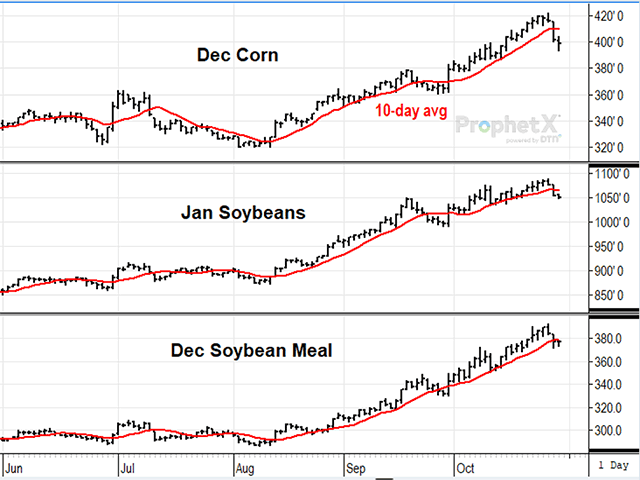Todd's Take
A Week of Contradictions in Grains
For corn and soybean prices, the surprises of 2020 seem to have no end. Not only did both crops produce unexpected rallies at harvest time, but their higher prices were accompanied by more-than-expected export sales nearly every step of the way.
The bullish, one-two punch combinations of higher prices, followed by more export sales, followed by higher prices, were especially relentless in October and drove speculative short positions nearly out of the market. As of Oct. 20, CFTC data showed noncommercial shorts down to 140,485 in corn, the lowest in five years. In soybeans, noncommercial shorts fell to 57,540, near the lowest total in over six years.
I mentioned how shorts were getting squeezed out of corn in DTN's Closing Market Video on Oct. 21 as a way of warning how previous tops in prices were accompanied by similar behavior. The reasoning is, when fundamentals are changing and perceived supplies are getting tighter, speculators holding short positions are most vulnerable and need to get out of the market. Once they do, the market loses an easy source of available and panicked buyers.
Of course, I didn't know corn and soybean prices would sell off as hard as they did Wednesday, but anytime speculative participation is as high as it had gotten in October, the market is ripe for unexpected volatility. Noncommercial traders are easily spooked and that proved true again Wednesday when nearly all commodities sold lower on investor concerns related to rising COVID-19 infections.
I'm not saying the rising infections are not a concern -- they obviously have economic implications and the examples of how distribution and food chains can go wrong are still fresh in our memories. But it was interesting to see that wheat prices did not suffer the same percentage losses Wednesday as corn and soybeans. The wheat markets do not have the same heavy noncommercial participation that we currently see in corn and soybeans.
P[L1] D[0x0] M[300x250] OOP[F] ADUNIT[] T[]
Knowing what we now do about corn and soybeans, the bullish argument for soybean prices is still as strong as it has been all year. Thursday's weekly report from USDA put soybean export commitments at 1.726 billion bushels (bb) or 78% of USDA's entire export estimate for 2020-21.
FOB soybean prices in Brazil for November are near 6-year highs and are $1.22 a bushel above the comparable price at the U.S. Gulf. Part of Brazil's high price may have something to do with the dry forecast for southern Brazil and Argentina, a forecast that coincides with the expected La Nina influence this winter.
In China, Thursday's soybean price on the Dalian exchange was the equivalent of $15.12 a bushel, motivation for China to buy more from the U.S. (Thanks to Ken Morrison for steering me to the correct soybean price. Friday's original figure of $20.15 in this column mistakenly came from a quote for non-GMO soybeans in China, the wrong comparison in this context.)
USDA's most recent estimate of 290 million bushels (mb) of ending soybean stocks is now looking too high. The easiest path for soybean prices still looks up, even after Wednesday's selling disruption.
For corn, the price rally in October has been uncomfortably ahead of its fundamentals after USDA estimated 2.17 bb of U.S. ending stocks and an average farm price of $3.60 a bushel.
However, export sales have increased and corn export commitments in 2020-21 now total 1.204 bb or 52% of USDA's export estimate. Mexico added another 35.1 mb to the total Thursday.
It is fair to wonder if part of the surge of demand for corn is related to countries wanting to secure supplies in case COVID-19 problems worsen again this winter. Talk of dry weather and the possibility of a lower corn crop in Ukraine this year doesn't hurt and there are the weather concerns for southern Brazil and Argentina that I mentioned above.
The most bullish clue for the possibility of more corn sales ahead is the high domestic price in China, closing Thursday at the equivalent of $9.82 a bushel. So far in 2020-21, China has signed up for 415 mb of U.S. corn and it seems fair to say USDA's estimate of China having 7.44 bb of ending corn stocks is not correct.
While the bullish case for soybean prices remains strong, the expectation for corn prices is not as clear and will likely be tied to South America's weather in early 2021. Both corn and soybeans have attracted heavy speculative attention and that will foster price volatility as we finish out this unforgettable year.
In grain markets, 2020 may long be remembered as the year of surprises, but we can't say they'll end in December.
Todd Hultman can be reached at Todd.Hultman@dtn.com
Follow him on Twitter @ToddHultman
(c) Copyright 2020 DTN, LLC. All rights reserved.




